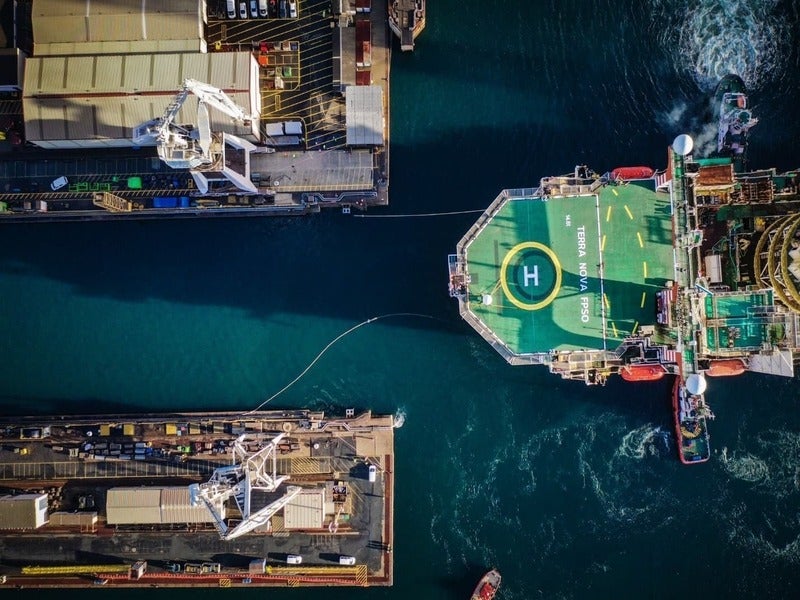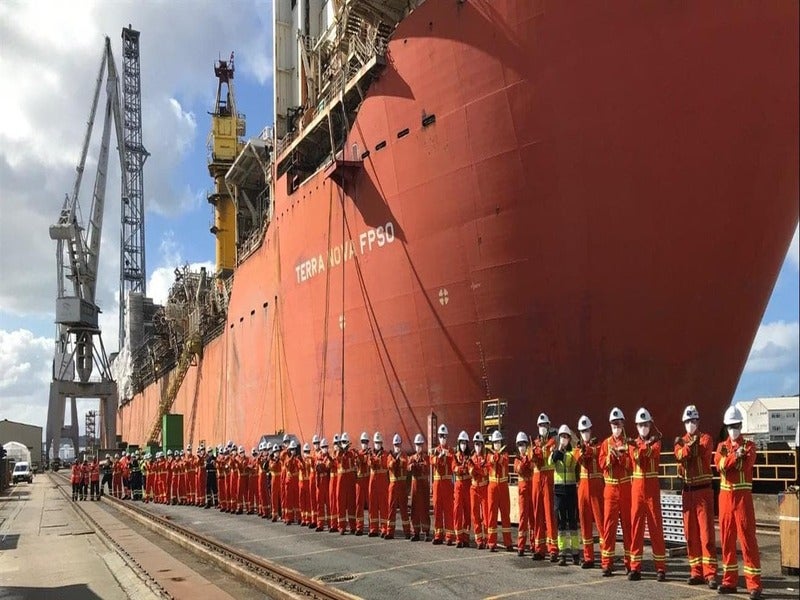The Terra Nova oil field is located off the coast of Newfoundland, Canada. It is regarded as the first development in North America to utilise Floating, Production Storage and Offloading (FPSO) technology in harsh weather conditions.
The offshore field was discovered in 1984 by Petro-Canada by drilling the Terra Nova K-08 well. Production began in January 2002.
In 2019, an Asset Life Extension (ALE) of the project was sanctioned. The FPSO was also moved for repairs.
The FPSO vessel resumed operations in November 2023.
Terra Nova is owned by Suncor Energy (48%, operator), Cenovus (34%), and Murphy Oil Corporation (18%).
Terra Nova Location
The Terra Nova Oil Field is located on the northeastern Grand Banks, about 350km southeast of Newfoundland and Labrador. It was the second asset to be developed on the Grand Banks.
Water depth in the area ranges between 90m and 100m. It is also characterised by the seasonal presence of icebergs and sea ice.
The Hibernia Oil Field is situated around 35km away from the field.
Geology and Reserves
The Terra Nova field includes four geological structural fault blocks- West Flank, Graben, East Flank and Far East.
The oil is recovered from the Jeanne d’Arc Formation in the Graben and the East Flank blocks.
According to the initial Terra Nova development application, the reservoir features a sequence of medium- to coarse-grained sandstones.
Initially, the field included an area of about 128km2 and was estimated to host around 400 million barrels of recoverable oil.
Based on production data acquired for January and February 2013, the Canada-Newfoundland and Labrador Offshore Petroleum Board (C-NLOPB) indicated that the Proven and Probable oil reserve of the Terra Nova Field is 506 million barrels.
The Proven and Probable recoverable gas resource was estimated at 64 billion standard cubic feet (Bscf) and the Natural Gas Liquids (NGL) resources were estimated at 4.6 million barrels.
Terra Nova Project Development
The Terra Nova oil field was developed using a ship-shaped FPSO vessel offering production facilities. The FPSO features an integrated oil storage from which oil is offloaded onto shuttle tankers.
The production wells were pre-drilled by a semi-submersible mobile offshore drilling unit. The subsea infrastructure is connected to the FPSO via a series of flexible risers and flowlines.
Overall, more than 40km of flexible flow lines transport hydrocarbons to and from the wells.
Produced gases are separated from the recovered oil and then re-injected into the reservoir to support production and potential future extraction.
Crude oil is shipped from the FPSO via large shuttle tankers.
Terra Nova FPSO
With a length of 292.2m and 45.5m width, the Terra Nova FPSO vessel is one of the largest FPSO vessels ever built. The vessel is more than 18 storeys high from the keel to the helideck.
It can store 960,000 barrels of oil and accommodate up to 120 people during operations.
The double-hulled, ice-reinforced FPSO is designed to withstand extreme weather conditions and environment. It is equipped with an ice-reinforced vessel with five thrusters and a global dynamic positioning system.
This enables the FPSO to maintain or change to favourable headings in high winds and storms.
The vessel can operate in moderate sea ice and disconnect to avoid heavy pack ice and collisions with icebergs.
An offloading system is used to transfer oil from the FPSO to shuttle tankers. The system can be connected or disconnected in up to 5m of wave heights.
Terra Nova Project Extension
The Terra Nova Asset Life Extension project will increase the life of the project by at least ten years offering an additional 80 million barrels of oil resource.
The overall project entailed around C$500m-C$600m capital investment.
The Asset Life Extension (ALE) Program was supported by two sub-projects- the Life Extension Turnaround (LET) and the SubSea Program (SSP).
LET involved off-station works with the FPSO scope of work performed in a Spanish dry dock facility.
It focused on design and/or condition-based concerns with the FPSO structure and replacement of key systems, as well as on the production efficiency and reliability improvements.
The SSP encompassed upgrading mooring system, water injection riser replacement, and replacement of up to eight spider buoy emergency shutdown valves among others.
Contractors Involved
ABB was engaged to deliver electric power systems to the Terra Nova FPSO and shuttle tanker.
In December 1996, the Grand Banks Alliance (GBA) was selected as the preferred contractor for the offshore field development. The scope of work included engineering, procurement, construction, installation, commissioning as well as pre-development drilling activities until production of first oil.
The GBA included SBR Offshore, Doris Conpro, PCL Industrial Constructors, Coflexip Stena Offshore, FMC Canada and Halliburton Company’s Brown and Root, Halliburton Energy Services and Landmark Graphics Corporation units.
At that time, the contract was valued at $1.2bn.





